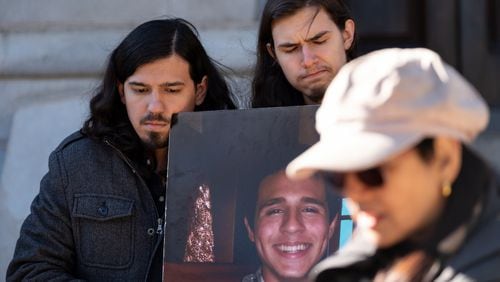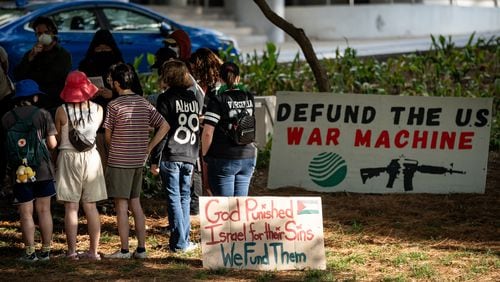Gunshot residue was “not seen” on the hands of an activist killed in January by Georgia State Patrol troopers at the site of Atlanta’s planned public safety training center, according to an autopsy report released late Wednesday by the DeKalb County Medical Examiner’s Office.
The long-awaited report also revealed that Manuel “Tortuguita” Teran’s body had at least 57 gunshot wounds, which included entrance and exit wounds, as well as re-entry and re-exit.
From the beginning, the activist’s family has disputed the GBI’s claim that Teran fired the first shot at troopers and has questioned the use of deadly force.
“We are devastated to learn that our child, our sweet Manny, was mercilessly gunned down by police and suffered 57 bullet wounds,” Teran’s mother, Belkis Teran, said in a statement.
The 26-year-old was killed Jan. 18 during a “clearing operation” on the wooded property in southern DeKalb. While the official autopsy report states “gunpowder residue is not seen” on Teran’s hands, it is not conclusive because gunpowder is not always visible to the naked eye. A gunshot residue kit was performed, but those results have not been returned from the GBI Crime Lab, the medical examiner’s office told The Atlanta Journal-Constitution.
An earlier private autopsy requested by the family estimated Teran suffered at least 14 gunshot wounds. But that examination was limited due to the body having been dissected during the first examination. That estimate likely came from the 14 projectiles or bullet fragments the county medical examiner recovered from Teran’s body or clothing during the initial autopsy.
The official autopsy report states that the gunshot wounds included one through the sole of the right foot and a likely fatal wound to the head that collapsed the right eyeball. Varying amounts of bleeding or bruising were noted with most of Teran’s wounds, indicating the activist was likely still alive during those injuries, the report states. That also suggests the gunshot to the head was likely not the first wound inflicted, as none of the other injuries would have immediately disabled Teran, the autopsy concludes.
Most of the injuries were determined to have had a front-to-back trajectory, though some to the lower body entered from the back and several others could not be determined, according to the report. Because of that, attempts to determine Teran’s body placement at the time of the shooting are “fraught with potential inaccuracies. There are too many variables with respect to the movement of the decedent and the shooters to draw definitive conclusions concerning (Teran’s) body position,” DeKalb Chief Medical Examiner Gerald Gowitt wrote.
The family’s private autopsy, performed by Kris L. Sperry, the GBI’s former chief medical examiner, however, suggested that Teran’s hands were raised at the time of the shooting. But it was not clear if they were raised above the head or were in a lower position.
Sperry retired abruptly from the GBI in 2015 after an AJC investigation found he had claimed hundreds of work hours at the state agency when he was actually working on more than 500 cases as a paid forensic expert, bringing his professional credibility into question.
In the county’s autopsy, Gowitt did note that one group of wounds to Teran’s left hand suggests it was in a clenched fist position during the shooting.
Weeks before Teran was killed, the state patrol’s SWAT team had been requested to assist the GBI and other law enforcement agencies in clearing the property of protesters who were “unlawfully occupying the land,” according to multiple Georgia Department of Public Safety use of force reports obtained by the AJC.
On the morning of Jan. 18, troopers began clearing the forest when they encountered dozens of tents, one of which belonged to Teran, the reports detail. Teran was inside and briefly spoke to officers but refused to leave. Troopers then fired pepper balls inside the enclosure in an attempt to drive Teran out and make an arrest for criminal trespassing.
The reports say Teran fired the first shot, allegedly wounding a trooper, and six officers returned fire.
The GBI has said that the bullet that struck the trooper had been fired from a gun found at the scene and provided documents showing it had been purchased by Teran in September 2020.
Teran’s family disputes those allegations and questions the veracity of the use of force reports submitted by troopers, noting that many of them were allegedly drafted weeks or months after the incident. The family argues officers had the opportunity to review publicly available video and news releases by the GBI before submitting their reports.
“We cannot even begin to determine what happened on the morning of January 18 until the GBI releases its investigation,” family attorney Brian Spears said Wednesday.
There is no body camera footage of the shooting, as state troopers are generally not equipped with cameras. Several other agencies were involved in the operation that day, including the Atlanta Police Department, which released a set of four videos in February.
Teran’s family has said the APD videos raise more questions, and other activists have focused on a single line uttered in the roughly two hours of footage, holding it out as evidence of a cover-up of the injured trooper being hit by friendly fire.
“Man,” the APD officer is heard saying before using an expletive, “you (messed) your own officer up.”
It is not clear, however, what the officer meant or could have known at the time he spoke, which was just minutes after the shooting and not within eyesight of the scene.







